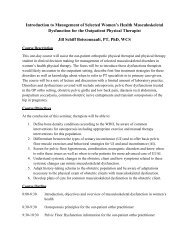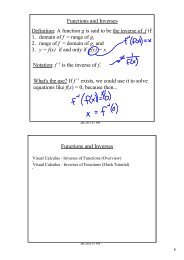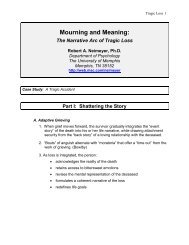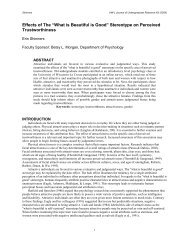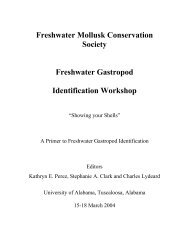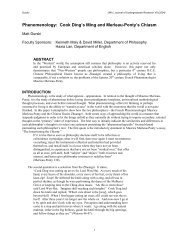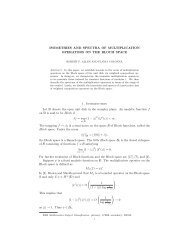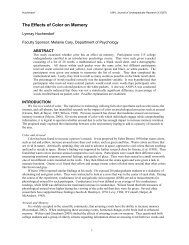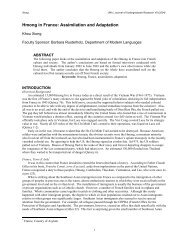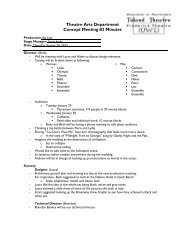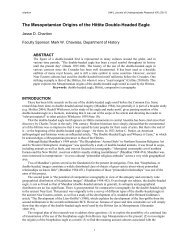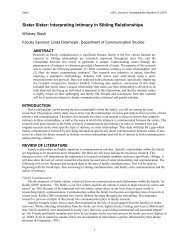A Good Study Break: Effects of Nature versus TV on Attention
A Good Study Break: Effects of Nature versus TV on Attention
A Good Study Break: Effects of Nature versus TV on Attention
Create successful ePaper yourself
Turn your PDF publications into a flip-book with our unique Google optimized e-Paper software.
Berigan and Pielage UW-L Journal <str<strong>on</strong>g>of</str<strong>on</strong>g> Undergraduate Research XVI (2013)<br />
<str<strong>on</strong>g>of</str<strong>on</strong>g> nature are perceived as beneficial for study breaks, but how does this compare to other ways that students relax<br />
when they are fatigued?<br />
Many college students in fact do not spend their study breaks looking at natural pictures or taking a nature walk.<br />
Instead, many choose to watch <str<strong>on</strong>g>TV</str<strong>on</strong>g>, YouTube videos, or movies. However, recent research has challenged the idea<br />
that these activities have restorative effects. Swing (2010) studied the effects <str<strong>on</strong>g>of</str<strong>on</strong>g> televisi<strong>on</strong> <strong>on</strong> attenti<strong>on</strong>. This study<br />
found time spent watching televisi<strong>on</strong> negatively affected performance <strong>on</strong> attenti<strong>on</strong> tests.<br />
The current study hopes to fill a gap in the existing literature by further investigating the c<strong>on</strong>necti<strong>on</strong> between<br />
<str<strong>on</strong>g>TV</str<strong>on</strong>g> viewing and attenti<strong>on</strong>, including the potential effects <str<strong>on</strong>g>of</str<strong>on</strong>g> nature <str<strong>on</strong>g>TV</str<strong>on</strong>g> (e.g., the film series Planet Earth) <strong>on</strong> attenti<strong>on</strong><br />
restorati<strong>on</strong>. Although there are several studies that support the use <str<strong>on</strong>g>of</str<strong>on</strong>g> nature in attenti<strong>on</strong> restorati<strong>on</strong>, n<strong>on</strong>e have<br />
looked into the use <str<strong>on</strong>g>of</str<strong>on</strong>g> nature videos. Research has also not compared the effects <str<strong>on</strong>g>of</str<strong>on</strong>g> nature exposure to <str<strong>on</strong>g>TV</str<strong>on</strong>g> exposure.<br />
Additi<strong>on</strong>ally, no studies look at the questi<strong>on</strong> <str<strong>on</strong>g>of</str<strong>on</strong>g> how l<strong>on</strong>g these attenti<strong>on</strong>al benefits can last, which is an important<br />
aspect to c<strong>on</strong>sider when applying these practices to real life situati<strong>on</strong>s. If the restorative effects <str<strong>on</strong>g>of</str<strong>on</strong>g> viewing nature<br />
<strong>on</strong>ly last for a few minutes, students will lose focus quickly and researchers may want to begin looking into different<br />
ways to restore attenti<strong>on</strong>.<br />
Based <strong>on</strong> previous research we hypothesize that experiencing actual nature will result in significantly better<br />
attenti<strong>on</strong> scores than watching nature shows, watching popular programs <strong>on</strong> televisi<strong>on</strong>, and experiencing semi-built<br />
envir<strong>on</strong>ments that include green space as well as buildings (e.g., a college campus). In additi<strong>on</strong>, we hypothesize that<br />
watching nature <str<strong>on</strong>g>TV</str<strong>on</strong>g> and experiencing a semi-built envir<strong>on</strong>ment will result in a significantly better performance <strong>on</strong><br />
the attenti<strong>on</strong> test than watching popular <str<strong>on</strong>g>TV</str<strong>on</strong>g>. Because there is no previous research <strong>on</strong> the durati<strong>on</strong> <str<strong>on</strong>g>of</str<strong>on</strong>g> restorative<br />
benefits, the current study will also explore how l<strong>on</strong>g these attenti<strong>on</strong>al benefits last.<br />
Method<br />
Participants<br />
In this study there were 70 participants recruited from the University <str<strong>on</strong>g>of</str<strong>on</strong>g> Wisc<strong>on</strong>sin-La Crosse through a website<br />
that enables them to sign up <strong>on</strong>line. Participants c<strong>on</strong>sisted <str<strong>on</strong>g>of</str<strong>on</strong>g> students from a variety <str<strong>on</strong>g>of</str<strong>on</strong>g> majors who signed up for the<br />
study with a mean age <str<strong>on</strong>g>of</str<strong>on</strong>g> 19.37 years (SD =1.55). However 7 participants had to be removed from the study due to<br />
cheating <strong>on</strong> the attenti<strong>on</strong> test so <strong>on</strong>ly 63 participants were used to c<strong>on</strong>duct the results <str<strong>on</strong>g>of</str<strong>on</strong>g> this study. Participants were<br />
compensated by having their name entered into a drawing to win <strong>on</strong>e <str<strong>on</strong>g>of</str<strong>on</strong>g> four $25 gift cards to the Three River<br />
Outdoors sporting shop.<br />
Materials and Procedure<br />
The design for this study was a single factor between-subjects design. The experimental variable was<br />
participants’ restorative activity (viewing actual nature, viewing a semi-built envir<strong>on</strong>ment, viewing nature <str<strong>on</strong>g>TV</str<strong>on</strong>g>, and<br />
viewing popular <str<strong>on</strong>g>TV</str<strong>on</strong>g>). The dependent variables included initial attenti<strong>on</strong> and l<strong>on</strong>ger term attenti<strong>on</strong>. Attenti<strong>on</strong> was<br />
measured using an assessment known as the Backwards Digit Span Test (Wechsler, 1955) taken before and after<br />
each restorative activity and repeated 10 minutes after the activity ended. This test has been successfully used in<br />
many attenti<strong>on</strong> restorati<strong>on</strong> studies (e.g., Berman et al., 2008; Taylor & Kuo, 2009). We used an oral versi<strong>on</strong> <str<strong>on</strong>g>of</str<strong>on</strong>g> this<br />
test that involved reading <str<strong>on</strong>g>of</str<strong>on</strong>g>f digit sequences (e.g., 7-3-5) and having participants write down the numbers<br />
backwards. The participants heard previously recorded sequences <str<strong>on</strong>g>of</str<strong>on</strong>g> numbers that increased by number <str<strong>on</strong>g>of</str<strong>on</strong>g> digits<br />
every two sequences. To further explain, the first two sequences <strong>on</strong>ly had two digits (7-5, 6-4) while the third and<br />
fourth had three (8-4-5; 7-9-1). Every two sequences served as <strong>on</strong>e level. Therefore, every participant heard fourteen<br />
sequences that equaled seven levels. If the participant got the first sequence <str<strong>on</strong>g>of</str<strong>on</strong>g> the level right, then they passed that<br />
level. If they got the first sequence wr<strong>on</strong>g, but the sec<strong>on</strong>d sequence right, then they passed that level as well. If both<br />
sequences were wr<strong>on</strong>g then they did not pass, the scorer looked at no more sequences, and the score (1-7) reflected<br />
the furthest level the participant successfully passed. (Berman et al., 2008).<br />
Before the study, all participants signed the informed c<strong>on</strong>sent waiver, filled out a demographic survey and<br />
listened to an introducti<strong>on</strong> to the study in a classroom close to where their treatment took place. After this, every<br />
participant performed an attenti<strong>on</strong>-fatiguing task for 10 minutes. The task was a syllogisms test that was designed to<br />
force participants to use logical deductive reas<strong>on</strong>ing to answer questi<strong>on</strong>s (Holmquist, 1974). We chose to use this<br />
task since it was successfully used in another study that looked at the restorative effects <str<strong>on</strong>g>of</str<strong>on</strong>g> nature (Kjellgren, 2010).<br />
There were 15 multiple-choice questi<strong>on</strong>s that participants had to answer <strong>on</strong> a sheet <str<strong>on</strong>g>of</str<strong>on</strong>g> paper in order to fatigue their<br />
directed attenti<strong>on</strong>. Next, participants took the first digit span test (pretest).<br />
Following this, each participant was randomly assigned into <strong>on</strong>e <str<strong>on</strong>g>of</str<strong>on</strong>g> the three restorative c<strong>on</strong>diti<strong>on</strong>s (semi-built,<br />
popular <str<strong>on</strong>g>TV</str<strong>on</strong>g>, nature <str<strong>on</strong>g>TV</str<strong>on</strong>g>) or they were assigned to the nature c<strong>on</strong>diti<strong>on</strong> based <strong>on</strong> the sessi<strong>on</strong> they signed up for. This<br />
modificati<strong>on</strong> was made because the first three c<strong>on</strong>diti<strong>on</strong>s could be experienced <strong>on</strong> campus while the fourth needed to<br />
2



